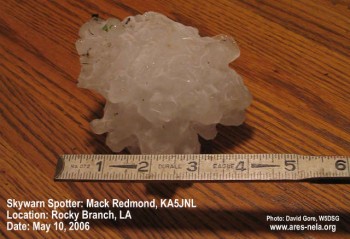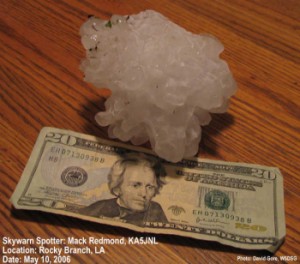

While severe thunderstorms produce tornadoes, they more commonly produce damaging winds and large hail. To be categorized as "severe" winds must be in excess of 55 mph and hail must be at least 3/4" in diameter or larger.
 Severe
thunderstorms usually come in two main varieties (althought there are others)
- the supercell and the squall line. A super cell thunderstorm is
likely to be isolated and exists in an environment of its own. They
have a complex internal structure and rotate. Therefore, it is these
thunderstorms that usually produce tornadoes. Tornadoes not withstanding,
they also produce strong winds and large hail. The squall line thunderstorm
is a solid or broken line of thunderstorms that form ahead of a large scale
boundary such as a cold front. Although a squall line thunderstorm
can produce a tornado, it is most likely to produce strong straight-line
winds, downbursts, and large hail. Winds associated with a squall
line can easily exceed 100 mph and give the appearance (and sound) a tornado
has struck. Many times people believe a tornado has struck their
location only to find it was a microburst or straight-line winds after
investigation of the damage pattern.
Severe
thunderstorms usually come in two main varieties (althought there are others)
- the supercell and the squall line. A super cell thunderstorm is
likely to be isolated and exists in an environment of its own. They
have a complex internal structure and rotate. Therefore, it is these
thunderstorms that usually produce tornadoes. Tornadoes not withstanding,
they also produce strong winds and large hail. The squall line thunderstorm
is a solid or broken line of thunderstorms that form ahead of a large scale
boundary such as a cold front. Although a squall line thunderstorm
can produce a tornado, it is most likely to produce strong straight-line
winds, downbursts, and large hail. Winds associated with a squall
line can easily exceed 100 mph and give the appearance (and sound) a tornado
has struck. Many times people believe a tornado has struck their
location only to find it was a microburst or straight-line winds after
investigation of the damage pattern.


SEVERE THUNDERSTORM WATCH Like the tornado watch, a severe thunderstorm watch is issued when conditions are favorable for severe thunderstorm formation. Many times a squall line situation is found within a severe thunderstorm watch. Keep in mind, severe thunderstorms can and often do produce tornadoes with little or no warning. TORNADOES CAN OCCUR WITHIN A SEVERE THUNDERSTORM WATCH! Should a severe thunderstorm watch be issued for your area, monitor the weather closely in case a warning is issued. Like the tornado watch, the severe thunderstorm watch is issued by the Storms Prediction Center in Norman, Oklahoma.
SEVERE THUNDERSTORM WARNING A severe thunderstorm warning is issued by local National Weather Service offices. Based on ground reports or by Doppler radar, conditions meeting the severe thunderstorm criteria are either occurring or are about to occur within the warned area. You should take shelter immediately.
AT HOME:
1. Stay away from windows.
2. Move towards the interior portion
of the home.
3. Bring pets inside.
MOBILE HOMES:
1. Abandon an untied or unanchored mobile
home.
2. Stay away from windows.
3. Move towards the interior portion
of the home.
CARS:
1. Abandon cars for more substantial
shelter until the storm has passed.
OUT OF DOORS:
1. Again, seek shelter if possible.
2. Find a low-lying area such as a ditch
or raving being cautious of rising water.
3. Do NOT seek shelter beneath trees
as damaging winds may cause them to break in addition to a potential lightning
strike.